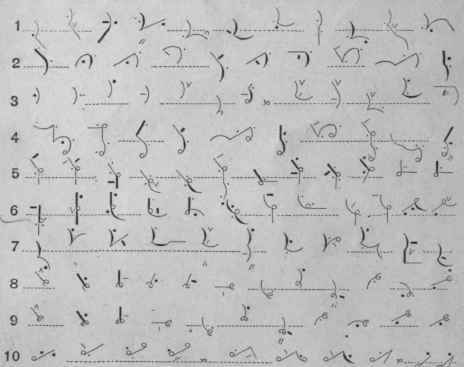Small Circle For S And Z
Description
This section is from the book "Phonetic Shorthand", by William W. Osgoodby. Also available from Amazon: Phonetic Shorthand.
Small Circle For S And Z
Sec, 8. S is most frequently represented by a small circle, initial or final, named Iss, written on the right side of an upright or inclined straight stem (except Ray), on the upper side of Ray, Kay, and Gay; and on the inner side of curved stems. The sound of Z may also be represented by the small final circle.
a. Between two straight stems which form an angle, a circle is written outside the angle. If one or both stems be curved, the circle is written within the curve. (Lines 12, 13.) b. An initial circle is always read before the stem, and before any vowels written to the stem. A final circle is always read after the stem, and after all vowels written to the stem. When the tick for H, or for Wh, is written before an initial circle, a vowel sound is always to be understood as occurring between the tick and the circle. The particular vowel will be sufficiently indicated, if the outline is written in its proper position. (Lines 13-18.)
Write Exercise IV. of the Speed-book.

c. When a vowel precedes S or Z, at the beginning of a word, and when a word ends with S or Z followed by a vowel, the stem must be used. The stem must also be used when S or Z is the only consonant in a word, and when two vowels occur between S or Z and a preceding or succeeding stem. {Lines 1-8.) d. When a singular noun ends with a stem S or Z, the circle is added to form the plural number or the possessive case; also, to form the third person, singular, of a regular verb ending with either of these stems. (Compare Sec. 9, a.) The circle may also be added to a word sign, for the same purpose. (Line 4.
e. If a circle occurs between two stems, vowels are necessarily written to the stem with which they are pronounced. (Lines 5, 6.) f. When Z is the first consonant in a word, the stem must be used. (Line 7.) g. A small hook may be made on the back of a stem ending with a circle, to indicate the sound of N following that of S; and another circle may be written within the hook for a finals. (Lines8, 9.) h. The circle is sometimes used for Sh, and with the back-hook forms the termination Tion, as is more fully explained in section 22.
i. If R is the only stem in a word, and it is preceded and followed by vowels, and also preceded by a circle or loop, Ray is used. Ray is also used when R is preceded by a circle or loop and followed by a downward stem. (See Sec. 10.) (Line 10.) j. Phrasing. - Is, His, As, Has, Us, or Say, is added to another word by the small circle. (Line 11.) k. Is, His, As, or Has, is prefixed to another word by the small circle. When thus used, Is and His are always written above the line, and As and Has on the line. (Line 18.)
Key to Lines 11 and 12. - All-is. Who-is. He-is. He-has. Before-his. What-is. Had-his. Which-has. For-us. Above-us. With-us. From-his. There-is.
Is-he. Has-he. As-if. As-though. As-was. As-shall. As-will. As-you. As-we. Is-so. Is-without. His-own.

Word-Signs

Continue to:


